In August 2006 twenty three members of the IMC and various friends of mine from around
the UK spent a glorious week climbing on Lundy Island. Lundy is is a three mile long, half
mile wide, and 400ft high mass of granite, situated in the Bristol Channel about 11 miles
from the North Devon coast. It is an atmospheric and adventurous venue for sea cliff
climbing that I have fallen in love with. This year was to be my fifth trip there and,
having already done many of the lower grade classics of the island, I was keen to try
something new and unusual, perhaps as part of a mid-week rest day. Whilst planning a ‘tick
list’ for this year’s visit I was looking for something suitable when I came across a
description of St Mark’s Stone. This is a small island about three quarters of the way up
Lundy’s West coast.
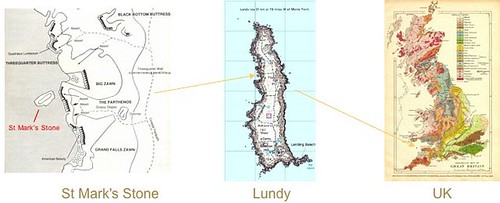 |
| Figure 1. The location of St Mark’s Stone, Lundy Island, UK (click on any image to view in Flickr) |
St Mark’s Stone
St Mark’s Stone is not even mentioned in the Lundy guidebook proper, which was last
printed in 1994; however its supplement – which is regularly updated and available online – describes a dozen low-grade
routes that were first climbed there in 1998. Not only are these routes new, they are also
difficult to reach. As with many of the Island’s climbs the approach would involve a long
abseil – some 50+ metres – but this would be followed by a 100ft swim! Yup, that sounded
suitably esoteric. The supplement notes that “all the routes were repeated in August
2002 by a well-prepared party who approached the island in a rubber dinghy”. Not being
able to afford a proper dinghy for the expedition I visited Felixstowe beach and bought a
child’s inflatable boat. This was immediately tested for robustness by my daughters.
To my surprise five other people said they were interested in joining me on a trip to
St Mark’s Stone. Simon and Steph are climbing friends of mine from Bristol who had joined
ranks with the IMC and visited Lundy on previous occasions. John Pereira had also been to
Lundy before but not for some time, whilst Alex Purser and Andy Hemsted were both Lundy
first-timers. Andy had stepped-in as a last minute substitute for Guy Reid,
who was recovering from his climbing accident at Swanage. One of the things I love about
climbing is the loose network of friends and contacts that you make whilst on your climbing
travels, and our party was a good example of this. We’d been climbing hard for 3 days so
Wednesday seemed like a suitable choice for our ‘rest day adventure’.
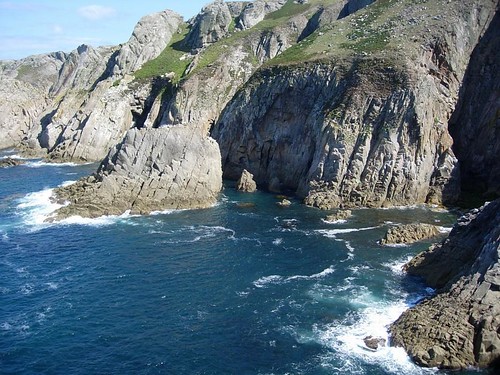 |
| Figure 2. St Mark’s Stone, 100ft offshore from the imposing cliff of ‘The Parthenos’ (in shadow). Photo taken by Alex Rigg from Beaufort Buttress. |
The Lundy topo showed that our abseil started from a spur to the North
side of Grand Falls Zawn. Simon and I had been here before in 2003. On that occasion we
had sat for some time on this spur looking back at the immense slab taken by American
Beauty, trying to summon up the courage to make the 250ft abseil and so commit ourselves
to doing that classic E1. This time we knew we were in roughly the right place, but not being
able to see down to the base of the cliff (as is often the case) we were unsure quite
where to abseil. Tying the 100 m static rope around a couple of large boulders I
threaded-in to my belay device and attached the backup prussik loop before starting a careful
descent down the loose fern-covered slope. This became steeper and more crumbly before finally
reaching solid rock, although I still descended slowly to avoid dislodging loose blocks
above. On reaching the bottom I yelled up that I was off the rope, and then started blowing
up the inflatable boat.
My plan had been to put the climbing gear in the boat and push it in front of me whilst
swimming across to the island. The boat could then be pulled back and the next person could cross with their gear. An alternative scheme was suggested – to set up a Tyrrolean Traverse between Lundy and St Mark’s Stone.
None of us had done this before but we gave it a try anyway. John volunteered to swim over to St Mark’s Stone with one end of the spare rope that we were intending to suspend across the gap. Off he went. On reaching ‘The Stone’ he realised that climbing pro, tape loops, nuts, etc. would be needed to attach his end of the rope to rock, so I swam across with my climbing gear in the boat. It quickly became clear that we weren’t going to be able to get the rope under enough tension for a person to haul themselves along it. We could have tried to increase the tension by setting up pulleys and using prussik loops, but the gap to the island was so big, and the rope so stretchy that we gave up on that idea. It just wasn’t going to take a person’s weight. Communication was now more difficult because two of us were on the island and four were still on Lundy, but we managed to change the plan. If we passed each end of the rope through runners attached to the rock then surely we could haul over bags of climbing gear suspended from the rope – rather like a cable car. Again this wasn’t successful. As the bag of gear neared the middle of the gap the rope was sagging so much that it started to dip into the sea. To pull the gear out of the water it was necessary to put the rope under so much tension (using italian hitches for example) that it was then impossible to move the rope one way or the other.
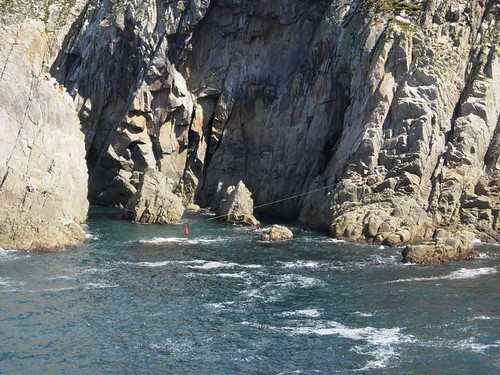 |
| Figure 3. Our failed attempt to haul climbing gear across the gap – photo Alex Rigg. |
By this stage lots of time (and energy!) had been spent fiddling about with the rope. It was time to revert to a modified form of ‘Plan A’. The gear would go in the big red drysac that was tied-in to the boat, and that would be pulled back-and-forth by the rope. One by one the remaining four crossed over, most of them swimming next to the gear-laden boat which was guided by the rope. At this stage the sea was pretty calm so getting in and out of the water was straightforward. In fact whilst the others were crossing I had fun jumping from rocks into the fantastically clear deep water. Andy, however, was not happy about the cold water so opted to sit in the under-sized boat and paddle over.
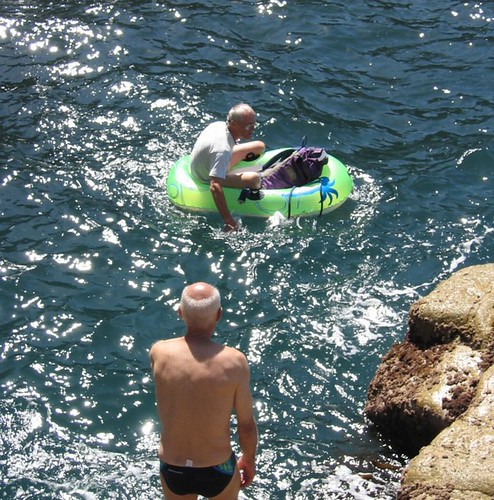 |
| Figure 4. Paddling across in the gift shop dinghy |
Throughout the crossing I was worried that the inflatable could be punctured by a sharp rock. I have to admit that I was fussing about this too much – but with all the difficulties we’d had getting it there I could imagine not being able to get our climbing gear back again without the boat.
Once on St Mark’s Stone you find that it’s got a friendy and relaxed feel. The main slab faces South so is warm and sunny, and rises from a large non-tidal platform on which it’s easy to lounge and take in the atmosphere. Most of the routes follow diagonal crack features on the main slab and all are at easy grades. These are marked on figure 5.
 |
| Figure 5. The routes on St Mark’s Stone. Photo Alex Rigg. |
In this photo John and Alex are on the far left-hand end climbing Lundy Offshore, marked by the green line. The straight diagonal chimney ending
at a is St Mark’s Chimney (Diff), whilst St Mark’s Crack (V Diff) is the line ending at b. Steph is leading St Mark’s Jugs (c) belayed by Simon Pelly. Leaning Difficulties is the straight chimney/crack ending at d, whilst the slab directly below (green line) is Swim for Victory, graded HVS but downgraded by Andy and me to VS at most. In this photo Andy and I have just finished the prominent straight line of Mary’s Jugs (e) and are looking for Arguably the Most Inaccessible Quality V Diff on Lundy. This is over on the right-hand end of the island and is – unsurprisingly – a V Diff. It’s reached by abseiling to some small ledges just above the high tide line. From this same point Simon and Steph created a new route called Blinded by Bermuda, in honour of my stunning shorts.
The slab’s diagonal lines are such strong features that most of the existing routes follow these. Whilst eating lunch and contemplating the rock my perverse mind decided that it would be fun to do something deliberately unusual. From this was born a new route Currently the most esoteric girdle traverse on St Mark’s Stone which Andy and I climbed in two pitches and graded VS. It’s two pitches are shown in figure 5 by the red and purple lines.
 |
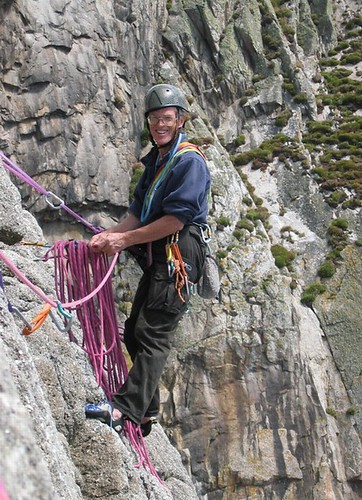 |
| Figure 6. Abseilng in to ‘Arguably the Most Inaccessible Quality V Diff on Lundy’ |
Figure 7. Andy belaying on our new girdle traverse. |
I really wanted to do more climbing but John pointed out with some concern that sea was getting noticably rougher. I wasn’t keen to leave because it still seemed early in the day, but John was quite right. Alex swam back first to take charge of pulling over the dingy’s guide rope, then we took it in turns to swim back with our gear in the dingy. The sea was now rising and falling with some considerable swell, and even getting into the water proved a tricky with Steph being knocked from the rocks into the sea. Having seen this most of us wore our climbing helmets while swimming back.
 |
| Figure 8. The return crossing |
Having made the strenuous 100ft return swim through a choppy sea you then had to get out of the water. Grabbing hold of the rock whilst the sea was at the highest point in its swell you were left clinging to slippery wet rock – above a nasty looking drop as the sea fell by some 10ft or more. Not nice. You then had a few seconds to scramble out of its reach before the sea rose and caught you again. Unfortunately the sea moves faster than you can climb. In attempting to scramble out several people ended up with cut feet, so I’d recommend suitable footwear if we ever do this sort of thing again. The other top tip is to use a length of rope as a handline. Those on shore coil this up and throw it over the head of the person in the water, aiming well past them. This makes it easier for the swimmer to find the rope and grab it as it falls onto them. They can then be hauled in by the helpers on shore. By holding your legs forwards rather like a water skier your feet hit the rock first – hopefully at the high water level – and you can be pulled out of the water by the rope, pivoting about your feet into an upright position above sea level. Only when standing almost upright do you grab the rock with your hands. It’s just as well we’d got this technique honed because while drying off and getting ready to change out of my wet clothes I knocked my rucksac off its ledge so that it bounced down the rocks and back into the sea. My camera was in there! Fortunately trapped air kept the sac afloat so I was able to jump back in to retrieve it, and then be hauled out again.
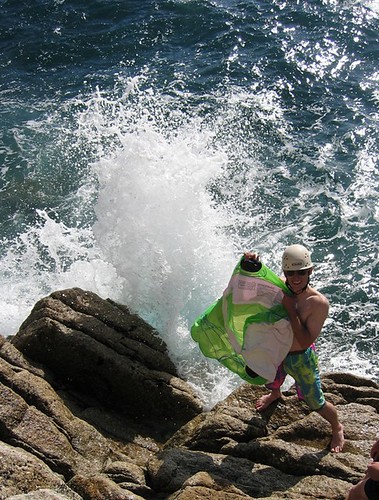 |
| Figure 9. Standing in front of our exit point from the sea. As a sign of how rough it was the water is spraying up to well over head height as it hits the rocks |
We were all safely back on Lundy island but the fat lady wasn’t yet singing. We still had to climb to the top of the cliff over fairly loose ground. Originally I’d planned to climb one of the routes in Grand Falls Zawn, but we’d been told by the Island’s nature warden that it was restricted due to the large number of birds that were still nesting there. To be honest at this stage I didn’t mind; the excitement of swimming back from St Mark’s Stone had left me feeling pretty tired. I now just wanted to see everyone safely to the top of the cliff and back to the Barn. The route up was technically easy, but the rocks soon gave way to loose grass and dry mud in which were embedded large boulders that had to be passed carefully for fear of dislodging them. Those people that were still left below the climber crouched behind protection out of the route of falling debris – or that’s what I wanted to happen. I can remember getting quite stressed when I saw this wasn’t happening. I really didn’t want to see anyone get hurt on my mad adventure, particularly after its success so far.
The Devil’s Slide by moonlight
Dinner that evening was a jolly affair. As usual we were all sitting around the huge table on The Barn, sharing meals, drinks and our tales of the day’s adventures. Spirits were high and, to my surprise, quite a few people said they’d like to join in with part 2 of my plan for the day – to climb The Devil’s Slide by the light of the full moon. The whole trip to the island had, in fact, been planned so that our visit coincided with a full moon. However, like most of the climbs on Lundy ‘The Slide’ is on the West coast, so the moon wouldn’t be seen from base of the slab until the second half of the night. It would need an ‘alpine start’, so I put in my earplugs and went to bed.
Somehow I woke at 1.30 am, just before my watch alarm was due to go off. That was good – nobody would be disturbed if the mission was aborted. Outside the full moon was shining brightly, but the sky was full of small clouds. They scurried quickly across the moon’s face, driven by the same wind that had made the sea so choppy during our return swim yesterday (!). Conditions weren’t great for climbing, and with all this cloud around I couldn’t even be sure that the moonlight would last for long. Should I wake the others? I woke Simon Pelly to ask his opinion. We decided that we would do it, so got ourselves ready to leave. Simon and I planned to go ahead of everyone else and to rig the abseil rope before they arrived; although I doubted anyone would really want to leave their bed to join us once the bravado of the previous evening had worn off. At the last minute I quietly woke those who’d said they were interested, and left The Barn.
Simon and I set off up the gravelled track on the East side of the island, planning to cross over to the West coast when we reached the Threequarter Wall. In this way, we figured, we’d go straight to the cliff at the top of The Devil’s Slide. It was a good plan, but we should have prepared by visiting the target area sometime in the previous few days; it was a bit late to realise that we hadn’t been there for 4 years! As you can probably guess, on arriving at the West coast we weren’t sure if we were in the right place. Uncertain of what to do we went North a bit, then South a bit, then back North – trying in vain to identify a feature we recognised. It all looked the same in dark. Finally we heard voices, so headed back South towards them. Right at the point where we’d originally arrived on the West coast we found all the others, heading down a gully that leads to the abseil boulder halfway down the edge of The Slide. Feeling pretty silly I mumbled something lame about taking the scenic route, then set about tying the abseil rope around the boulder.
I arrived at the bottom of The Slide first. It felt eery to be alone in the darkness with an angry sea crashing into the base of the rocky platform. Far above I could see half a dozen head torches dancing around, but all I could hear was the pounding sea. By the time Simon arrived our ropes were flaked out and I was ready to go. At first I tried to leave my headtorch off. Sure, the climbing was easy even without much light – just pad up the super sticky granite slab – but I found it difficult to spot where to put protection, even when leaving long gaps between the placements. I chickened out and turned my head torch on. Soon I arrived at the halfway break, level with the big boulder that we’d abseiled from. There were still plenty of people there, queuing. Despite it only being 2:30 am four other pairs of climbers had joined the party. It looked like this adventure had turned out to be too popular.
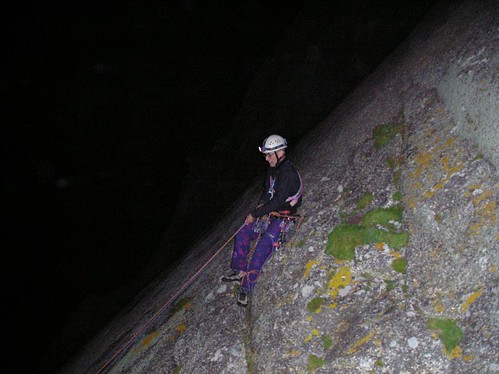 |
| Figure 10. Belaying at the halway break on The Devil’s Slide. Photo taken by Ian Thurgood from the abseil boulder. |
By the time Simon and I arrived at the top of the climb, three more pitches later, the sun was rising and a warm glow hugged the horizon. Caroline and Mike met us at the top of the cliff; our rucksacks brought up from the abseil boulder and the abseil rope already packed. Being at the back of the abseil queue they’d got too cold and decided not to do the route, particularly since they wouldn’t actually be doing it by moonlight. Four pairs, it seemed, were as many as The Slide could accommodate in one night. We didn’t wait for all the others to finish climbing, but set off back for The Barn to catch some sleep. After all, it was dawn and another days climbing was beckoning …
